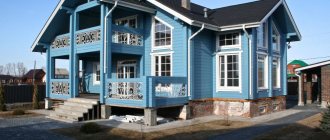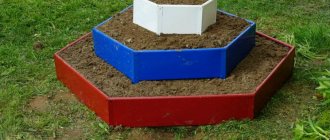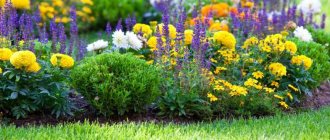Picket fence
Perhaps the most popular type, it is quick to assemble, almost any boards will do, it can be made as a blank shield, or it can be made with a small distance between the elements. Not only does it cover the area from the eyes of passersby, but it can also perform a decorative function and, if desired, can be easily combined with other types or transported to a new location.
Advantages of wooden fencing
The advantages of wooden fencing are obvious:
- environmentally friendly product;
- aesthetic features regarding texture, shades with which you can create a unique style;
- compatibility with other materials;
- high degree of protection from unnecessary attention;
- quick and easy installation;
- repairing a fence is an easy, and most importantly not costly, process;
- optimal price-quality ratio.
Despite a lot of positive criteria, wooden fences also have minor disadvantages. Requires careful treatment against mold and small insects.
We recommend watching a video about antiseptics and paints for wooden fences.
Fence palisade
One of the oldest types of fence, a wall of logs dug in close to each other, with a point at the top, labor-intensive to construct, but reliable. It is quite difficult to break it, and if such a waste of wood does not seem advisable, you can use bamboo.
Basic requirements for fences
In order for wooden fences, curbs and other barriers to be strong, reliable and last for many years, it is necessary to adhere to the following structural requirements for their construction.
- The maximum section length is 2.5 m. This is explained by the fact that wood is not a lightweight material, so failure to comply with this recommendation will lead to increased load on the supporting frame and sagging of the structure.
- The installation depth of the support pillars should be equal to the depth of soil freezing in the region (usually 80-120 cm). In this case, the size of the underground part of the support must be at least a quarter of its total length. It is also important to take into account the groundwater level, soil characteristics and other factors that can affect the properties of the soil in the off-season.
- The supporting pillars located at the corners of the perimeter and serving as the basis for gates and wickets must be thicker.
- The distance between the bottom line of the canvas and the ground surface should be at least 15 cm.
- The support pillars must rise above the upper border of the fence sheathing by at least 10 cm.
Checkered fence
An improved version of the picket fence, the boards are attached alternately from the outside and inside in a checkerboard pattern. You can also make a blind version or with small gaps, it looks difficult, but if you follow the order of fastening, anyone can assemble it.
Why do this?
There are several reasons why we plant plants along the fence and look for other ways to improve its appearance.
- Soften the strict geometry and dilute the monotony of a neat but boring wall made of wooden picket fence (brick, corrugated board).
- Conceal partially collapsed wood or fallen brick.
- Add privacy to the garden. This is especially true if it is fenced with a forged lattice or chain-link mesh.
- Support the stylistic theme of flower beds and landscape compositions for which the fence acts as a background.
Article on the topic: How to insulate the floor in a wooden house under laminate
Ranch fence
Although the name and appearance hint at the American roots of this fence, it is used everywhere. An excellent option for temporary construction or as a decorative element, but it will not hide from prying eyes.
Wattle
Wattle fence is the oldest and most cost-effective type of fencing. To create it, flexible branches of various trees or shrubs are used.
In the middle zone, wattle is most often made from willow or hazel twigs. They can be placed both horizontally and vertically, creating various wicker patterns.
As a rule, wattle fence is used for zoning a playground, recreation area or flower garden. However, sometimes a wicker fence is used to fence an entire area. Such a fence fits especially organically into a site decorated in ethnic or country style.
Wattle is also used in the garden - to fence high beds.
Fence blinds
It got its name from a famous office curtain. The boards are mounted on guides at an angle. The main difficulty in its construction is the need to use a foundation.
Tree species
The wood used to build a fence must be properly seasoned and protected from moisture, fungi and insects. It is best if it was impregnated at the factory.
Pickets that are located close to the soil are especially vulnerable to dampness. Such fences must be built with the greatest strength. Less durable wood can be applied to a fence supported by a primer.
Fence elements are most often built from deciduous or coniferous wood. Harder and more durable exotic wood (thuja, merbau, massaranduba) does not require impregnation and can be renewed less frequently. However, it is used less frequently due to its high price. Therefore, a cheap wooden fence made from such boards will not work.
Among domestic deciduous species, oak species are the most durable, and among coniferous species, larches are the most durable. For posts and boards, less hardy but cheaper wood from deciduous trees (acacia, elm or ash) or coniferous trees (pine or spruce) is most often chosen. How much does a wooden fence like this cost? Cheaper than thuja.
Popular woods such as alder or ash are also less durable. Birch, linden or sycamore boards should not be used, as they quickly deteriorate despite regular maintenance.
Wicker fence
This type of fence is made from branches or parts of a vine and looks rather flimsy, but it is not. There are some difficulties in creating it, many small actions, a couple of mistakes can lead to the need to redo part of the work.
From choosing a fence, we move on to choosing the material, and the most important thing here is the type of wood. It would be best to use Siberian larch; contact with water only makes it stronger, and this is very good for outdoor construction. A common option is pine, which is sold almost everywhere and is relatively cheap, but it is not advisable to make support posts from it. Oak, ash and walnut will also perform well. It is better to refrain from using birch; it is extremely unstable.
How to care for a wooden fence
Wood is prone to deterioration, but there are methods that will help maintain its original appearance:
- To prevent wear, the material is treated with bitumen or drying oil. Bitumen is applied to the lower part, which will be placed in the ground. This way the material will not rot. The boards are covered with drying oil 2 times.
- To prevent cracks and swelling on the crossbars, use paint for exterior use. Requires application in 2-3 layers. After this, the fence is treated with varnish. This process needs to be repeated after 2 years.
- Carry out periodic inspection of hinges and bolts that can damage the wood. Any unusable worn parts are replaced. For prevention, you can treat metal components with an anti-corrosion substance.
There are many types of wooden fences. The choice depends on personal preference, but the overall landscape should also be taken into account.
Wooden picket fence
Perhaps the easiest to build and unpretentious in materials. You can use a non-edged board for this, but it would be much better to use an edged one; it is cleared of bark and does not require pre-selecting locations for fastening elements.
First of all, you need to prepare wooden posts for the fence: select those that are suitable in length (remember that about a quarter will be in the ground), and immediately treat them with substances that protect against moisture.
Now we dig them in by a quarter, with a distance of 1.5-2 meters; some prefer to concrete them in the ground, but it is better to use special consoles on which the pillars are separately attached. We pull the rope tightly between the supports, this will help level the future fence. We drive a nail into the top of each post and stretch the string to control the height.
Note!
Do-it-yourself porch to the house - the best projects and construction ideas (125 photos of new products)
DIY brick barbecue: diagrams, drawings, photos, dimensions. Review of simple and complex structures on a summer cottage!
House with a bay window - 150 photos of the best planning and design ideas. Overview of all features of an architectural element
Now understanding what length and quantity of boards are needed, we prepare them, saw them off where necessary, and treat them with a special anti-corrosion solution. Protection can be purchased at the store, or you can make it yourself; the recipes are not complicated and are not a secret. The time has come to attach the horizontal guide boards, they must be strong, the optimal thickness is 25-30mm, they are located at a distance of approximately 30cm from each other.
For fastening, it is better to use screws of such length that they protrude slightly from the other side of the post. Now we attach the sheathing, depending on the desired result, the boards can be screwed close to each other, or with a gap. When doing this work, you should use a plumb line, then the fence will turn out smooth and beautiful. After complete assembly, the last important task remains, painting the wooden fence.
You can use any color and type of paint, as long as it is suitable for the street and weather conditions.
If someone finds this fence too boring, then you can always try to make something more complex. But keep in mind that different fences require different stages of work and preparation; in some cases you cannot do without concrete pillars or you will have to work not with boards, but with logs, which is quite difficult physically. By following the recommendations, you will definitely be able to make a wooden fence with your own hands, without the involvement of builders.
Combining wood with other materials in the manufacture of fences
In order to make a fence more durable, cheaper or more beautiful, a combination of wood and other building materials is used:
- brick;
- stone of various modifications;
- concrete and reinforced concrete;
- metal picket fence and metal profile;
- metal forging;
- waste material.
Most often, the material for combining in a wooden fence is used to make a base (so the structure becomes stronger, more reliable and more durable) or columns (pillars) to which the wood is attached (for the same reasons).
But it happens that secondary material for combination is introduced solely for decorative purposes. Like, for example, the forged elements at the top of this fence.
And in conclusion. Color solution
Of course, wood without additional surface treatment will not serve as a fencing material for long - climatic influences can be too harmful. In order to protect wood from rotting from constant exposure to precipitation and fading from direct sunlight, impregnation with special antiseptics and coating with varnishes or paints is necessary. Whether you need to give your fence a new color or preserve the natural grain of the wood is up to you. Much depends on how the wooden elements are made on the facade of the building and other participants in the landscape design of the site (if any) and your desire to harmoniously fit the fence into the overall picture or make it an accent element.
If the main building has painted wooden elements, then it would be logical to use this color scheme for the fence. For example, snow-white inserts on the facade of the house (roof gable, ridges, columns, balcony or terrace and other elements) and additional buildings will echo the similar design of the fence and create a festive image of the entire ensemble.
The tree can not be deprived of its natural pattern, but at the same time change the original shade. Using translucent varnishes, stains and other impregnating agents and coatings, you can achieve a color that, for example, will ideally match the color of the facade of a building (brick, stone or decorative material of non-natural origin).
But in most cases, the tree is left in its natural appearance. Moreover, no other material is capable of bringing so much natural warmth to modern buildings, the basis of which is concrete, glass, metal and foam blocks in gray tones.
How to Install Fence Posts
Before installing the support pillars, you need to drill holes to a depth of 0.5-1 m in the places where the stakes are dug. Pits are made using a drill (manual or electric). For vertical posts, timber with a cross section of 75x75 mm is used. Before installing the supports, it is necessary to thoroughly treat the part of the timber that will be in the ground.
The treatment is carried out by soaking the lower parts of wooden supports in antiseptic impregnation for 48 hours. After this, the pillars must be thoroughly dried.
Scheme of a wooden fence.
Additionally, you can protect a wooden stand from rotting by concreting. The bottom of the pit is covered with a small (1/3 of the depth) layer of sand and crushed stone, watered with water, a beam is installed and filled with concrete mortar. While the concrete has not set, the support is raised slightly to allow the solution to penetrate under the base of the post. Next, using a plumb line or level, the beam is installed vertically.
In order to make sure that the height of all vertical supports is the same, it is necessary to hammer a nail into the upper end of each beam and pull the cord tightly between them. The resulting line will show how correctly the height of all supports is selected. Allow at least three days for each support to dry completely.
An unusual wooden fence in the courtyard of a private house.
Wood maintenance
The first maintenance should be done before the fence is even built. The wood must be dry. If the wood has not been impregnated at the factory, it should be treated with a preservative or oil.
If you need to give the boards a natural color, you can choose a color impregnation or paint the boards. Acrylic enamels, which dry quickly, are best suited.
The most popular way to protect wood is to apply varnish, which not only protects the wood, but also gives it color and shine. It is applied in two layers. The varnish is easy to use and its effect lasts up to several years.
Preparation of materials and tools
To build a wicker fence with your own hands you will need:
- metal or wooden stakes;
- willow vine stems;
- sledgehammer;
- pruning shears, knife, wire.
The twigs are collected in spring or autumn, choosing the straightest branches possible. After collection, the shoots must be dried and collected in bunches for storage. Before constructing the fence (15 minutes before weaving), to make the rods flexible, they are thoroughly soaked or steamed. After laying, the woven branches dry and acquire a strong structure.
Strawberry bushes are planted in a flowerbed with a fence made of twigs.
Wooden or metal stakes are prepared for the frame. To prevent the supports installed in the ground from rotting, prepare a trench around the perimeter of the future fence and fill its bottom with sand. Thanks to this, moisture will drain and quickly pass through the sandy base into the soil.
On a note! To give the structure of a wicker fence strength, it is recommended to deepen the support stakes by at least 0.5 m.
For the frame of a wicker fence, you need to prepare wooden or metal stakes.
DIY wicker fence. Photos of rustic fencing
Lately, DIY decorative wooden fences have become popular. Photos of such fences show that their main purpose is not protection, but a symbolic stylized framing and decoration of a personal plot or a small area thereof. Wicker fences are quite easy to build. After studying the step-by-step instructions, you can learn how to make a wicker fence with your own hands.
A wicker fence looks unusual and original.
Price
Due to its affordable cost, a palisade is the most common method of fencing. The approximate price with installation is presented in the table below.
| Height, m | Thickness, cm | Price 1 m.p., rub. |
| 1,6 | 9 | 1550 |
| 2,1 | 10 | 1750 |
The process of constructing a fence from logs is quite simple. It does not require any special knowledge in the construction industry.
Massive fence
The most important thing is to approach the work responsibly and follow all preparation and installation rules. As a result, your summer cottage will have a beautiful and durable fence that can last for decades.











